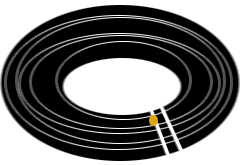

Purpose: The sport of distance running has been growing in popularity over the past several years. This week, Scientific AmeriKen will investigate recovery time after long runs.
![]()
Hypothesis: In a general sense, more is better. It is therefore the hypothesis of this experiment that allowing the body to rest for a longer period of time will allow for a better mile time.
![]()
Equipment: Needed for this experiment is a stopwatch, a track which a mile can be measure, a pen and a piece of paper.
Procedure: The first step of this experiment is to run a mile and record the time, then rest for 15 minutes. After the rest period run and time another mile. Repeat with 10 and 5 minute rest times and compare the difference between the two miles for all three rest times.
![]()
Results:
| Mile #1 Time | Rest Time | Mile #2 Time | Difference |
| 6 19' 89'' | 15 minutes | 7 49' 17'' | 1 29' 28'' |
| 6 33' 03'' | 10 minutes | 7 29' 33'' | 56' 30'' |
| 5 59' 99'' | 5 minutes | 7 46' 93'' | 1 46' 94'' |
![]()
Conclusion: Judging from the results, it appears as though there is an optimum range of rest time. The hypothesis of 'more is better' appears to be refuted as the difference between the two mile times was the smallest when only 10 minutes of rest was allowed. The reason may be related to the difficulty in keeping the muscles warm during the long rest and the difficulty of catching one's breath during the short rest. One factor that may have influence on the results is an increase in general fitness over the course of the experiment. Increased fitness may increase recovery time, however, it is believed that this factor will not be expressed after only the third day. Furthermore, the experimental results require more data to validate, however, a lack of desire make further experimentation very unlikely.